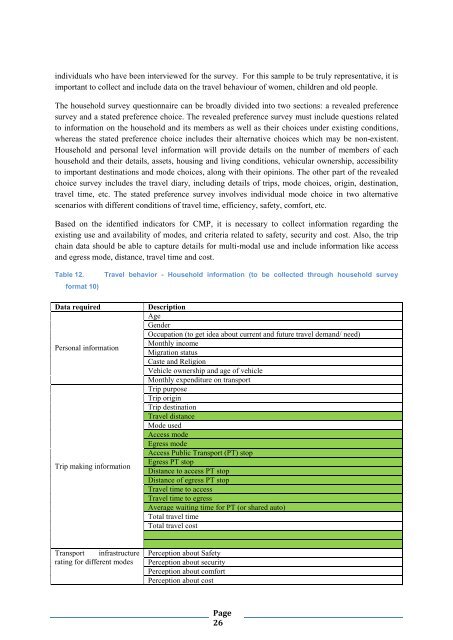Toolkits for Urban Transport Development - UNEP
Toolkits for Urban Transport Development - UNEP
Toolkits for Urban Transport Development - UNEP
Create successful ePaper yourself
Turn your PDF publications into a flip-book with our unique Google optimized e-Paper software.
individuals who have been interviewed <strong>for</strong> the survey. For this sample to be truly representative, it is<br />
important to collect and include data on the travel behaviour of women, children and old people.<br />
The household survey questionnaire can be broadly divided into two sections: a revealed preference<br />
survey and a stated preference choice. The revealed preference survey must include questions related<br />
to in<strong>for</strong>mation on the household and its members as well as their choices under existing conditions,<br />
whereas the stated preference choice includes their alternative choices which may be non-existent.<br />
Household and personal level in<strong>for</strong>mation will provide details on the number of members of each<br />
household and their details, assets, housing and living conditions, vehicular ownership, accessibility<br />
to important destinations and mode choices, along with their opinions. The other part of the revealed<br />
choice survey includes the travel diary, including details of trips, mode choices, origin, destination,<br />
travel time, etc. The stated preference survey involves individual mode choice in two alternative<br />
scenarios with different conditions of travel time, efficiency, safety, com<strong>for</strong>t, etc.<br />
Based on the identified indicators <strong>for</strong> CMP, it is necessary to collect in<strong>for</strong>mation regarding the<br />
existing use and availability of modes, and criteria related to safety, security and cost. Also, the trip<br />
chain data should be able to capture details <strong>for</strong> multi-modal use and include in<strong>for</strong>mation like access<br />
and egress mode, distance, travel time and cost.<br />
Table 12.<br />
<strong>for</strong>mat 10)<br />
Travel behavior - Household in<strong>for</strong>mation (to be collected through household survey<br />
Data required<br />
Personal in<strong>for</strong>mation<br />
Trip making in<strong>for</strong>mation<br />
Description<br />
Age<br />
Gender<br />
Occupation (to get idea about current and future travel demand/ need)<br />
Monthly income<br />
Migration status<br />
Caste and Religion<br />
Vehicle ownership and age of vehicle<br />
Monthly expenditure on transport<br />
Trip purpose<br />
Trip origin<br />
Trip destination<br />
Travel distance<br />
Mode used<br />
Access mode<br />
Egress mode<br />
Access Public <strong>Transport</strong> (PT) stop<br />
Egress PT stop<br />
Distance to access PT stop<br />
Distance of egress PT stop<br />
Travel time to access<br />
Travel time to egress<br />
Average waiting time <strong>for</strong> PT (or shared auto)<br />
Total travel time<br />
Total travel cost<br />
<strong>Transport</strong> infrastructure<br />
rating <strong>for</strong> different modes<br />
Perception about Safety<br />
Perception about security<br />
Perception about com<strong>for</strong>t<br />
Perception about cost<br />
Page<br />
26
















